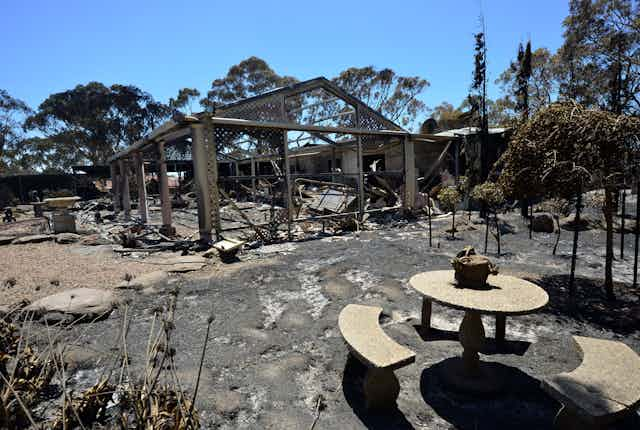Dozens of homes and outbuildings have been destroyed in bushfires that have ravaged parts of South Australia reminding us again how poorly adapted we are to bushfire prone landscapes.
With 15 years experience in design and planning to mitigate bushfire risk I have found that the two main barrier to affordable bushfire-responsive housing are:
- misinformation on the cost of building in bushfire prone areas
- difficulties delivering an holistic design approach that integrates buildings and their landscapes in one risk mitigation/dwelling environment.
Misinformation on cost
There is a growing public perception that building to the Australian Standard for construction in a bushfire-prone area – AS 3959:2009 – is unaffordable.
This can be attributed to published construction cost premiums applied to each of the six bushfire attack levels (BAL) outlined in AS 3959, from BAL-Low, BAL-12.5, BAL-19, BAL-29, BAL-40 to BAL-FZ (Flame Zone). The source of these costings is the Australian Building Codes Board’s Regulatory Impact Statement for AS 3959:2009.
This costing matrix, which has been represented on various state and local government websites around Australia such as City of Swan, in Western Australia, puts the extra cost of complying to the standards as up to A$20,885 for a “base home”.
These premiums have been derived from simplistic calculations where, for example, fibreglass fly screen mesh is upgraded to stainless steel ember mesh, or float glass is replaced with toughened safety glass.
The problem with this costing approach is that it assumes as a given, generic base house styles such as weatherboard construction and elevated lightweight construction. Elements are then substituted or added, such as the addition of bushfire shutters over conventional windows.
It is a very rudimentary costing exercise to take a generic home type and then substitute elements and ignores factors that contribute significantly to costs when building in bushfire prone areas.
Often the greatest contributor to cost is not the bushfire standards but the national energy rating requirements. This is because bushfire prone areas are both quite cold in winter and very hot in summer.
In these climate zones you need a building with mass – such as masonry – but also an open building with sufficient glazing to capture the winter sun and openings for natural cross ventilation.
The constraint against integrated design
Good design is about cross purposing – achieving more with less. So what designers should be looking for here are opportunities to integrate the otherwise disparate aspects of topography, thermal mass, radiant heat protection, insect control, flame contact, thermal comfort, sun shading, site access and escape into one holistic design.
One very practical example of this design approach is to eliminate veranda overhangs and eaves – which are proven weak links in bushfires – and replace these with perforated metal retractable shutters over windows.

These shutters then control the sun, insects, glare and wind as well as embers and radiant heat. Our research has found that this delivers a significant cost saving, but importantly, the bushfire risk mitigation device is used on a daily basis rather than once in an emergency. That is, it is integrated into the daily life of the home – it is not a rarely used add-on.
Standards and planning
What further impedes the integrated design approach is a disconnect between AS 3959 and the bushfire-specific site planning regulations of our state and local governments.
For example, there is no provision in AS 3959 for the design of escape routes from dwellings.
More concerning is that there is usually no requirement to apply this building standard at all unless the site has first been formally declared as a Designated Bushfire Prone Area. WA is about to declare all areas within 100 metres of bushland that is greater than 1 ha in area as bushfire prone.
Once declared, it is virtually impossible to mandate the application of the standard to existing dwellings via retrofitting. So we can have the now not uncommon situation where a well designed bushfire responsive house has a neighbouring property with a fire prone timber bungalow.
The False-Sense-of-Security myth
Perhaps the greatest constraint to the integrated design approach is the reticence of fire authorities and local governments across the country, to support the two highest levels of bushfire design BAL-40 and BAL-FZ.
The perception here is that for home owners to build to these levels would create a false sense of security, placing them in unexpectedly high levels of danger.
The reality is that every level of BAL represents the same level of risk – the lower the BAL the greater the distance between a dwelling and the bushfire prone vegetation. The higher the BAL the closer that vegetation can be to that dwelling.
But agencies encourage the building of conventional houses with low to mid-range BAL level features – no higher than BAL-29 – and then expect the homeowner to actively manage the vegetation hazard.
The problem that we see every fire season is that these active measures are frequently not carried out despite the many annual warnings for home owners to be prepared for bushfires.
For the fire authorities to promote this approach is somewhat paradoxical because the first principle of risk mitigation is to prioritise passive protection (such as building better bushfire protection) over active measures (keeping hazard vegetation cleared). Compared to permanent building features, landscapes are highly dynamic and far less dependable.
The reticence within agencies to promote better design reflects misconceptions about costs of implementing the building standard and the underlying risk mitigation principle.
An integrated approach places emphasis on active vegetation management where this can be practically achieved and building design solutions that deal with the many aspects associated with living in bushfire prone areas.
Only then will we start to see a reduction in the number of homes and properties destroyed when bushfires strike again.

